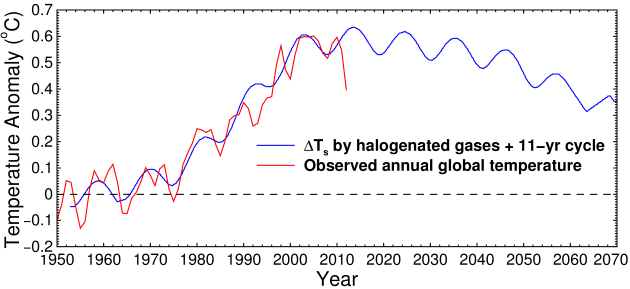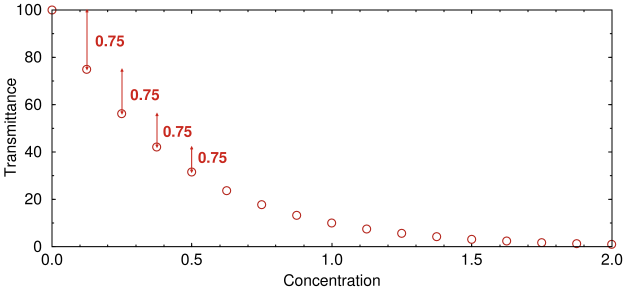 he 0.9° of global warming that occurred over the 20th century was once thought to
be primarily due to anthropogenic carbon dioxide (CO2) emissions. However,
computer models, and the conclusions drawn from them, have drawn skepticism for failing
to account for well known time-related features of warming (see Fig. 1):
he 0.9° of global warming that occurred over the 20th century was once thought to
be primarily due to anthropogenic carbon dioxide (CO2) emissions. However,
computer models, and the conclusions drawn from them, have drawn skepticism for failing
to account for well known time-related features of warming (see Fig. 1):
- Nearly constant from 1850 to 1920
- Slow increase 1920 to 1950
- Slow decline from 1950 to 1970
- Rapid increase 1970 to 2000
- Nearly constant 2000 to present
Moreover, CO2 has been increasing continuously since the beginning of the industrial era, while most of the global warming took place between 1970 and 2000. Since then it has paused or stopped. Many attempts have been made to dispute the existence of a pause. Nevertheless, it is clear that, even without the pause, the CO2 theory cannot account for many of the features of warming.
The most obvious alternative theory has to do with variations in solar output. Sunspots are correlated with increases in solar luminosity of up to 0.3% in the short term and 0.07% averaged across the maximum. Sunspots have been decreasing continuously since 2000: the latest peak in 2014 was the smallest in many decades. At present (2017) we are in a deep solar minimum (see here for a good discussion of sunspots). It is generally agreed that decreases in solar irradiance could account for some of the “pause.”
However, CFCs (chlorofluorocarbons), which were used as refrigerants until they were banned in 1987, can also affect the Earth's temperature. Global warming accelerated around 1970, just as air conditioning became widely affordable, and it ended (or “paused” depending on your point of view) about a decade after CFCs were banned. After 1987, CFCs were replaced by hydrofluorocarbons, which have a much lower ozone depleting potential.
Unappreciated at the time, CFCs also can absorb longwave infrared radiation. They absorb much more strongly than carbon dioxide, and at different wavelengths. Thus, despite their lower concentration, they are actually much stronger greenhouse gases than CO2. Because their concentrations are lower, their absorption is not already saturated.

Fig. 1. Global temperatures and atmospheric CFC concentrations in the northern hemisphere vs time. Data from [3–5]. Note: greatly expanded y-axis for temperature. Temperatures are binned into one-year intervals.
It might seem ironic that the invention of air conditioning would lead to an increase in atmospheric temperature, almost as if nature were toying with us. But this might be exactly what happened: simulations by Dr Q.-B. Lu of the University of Waterloo in Canada show convincingly that up to 97% of the 20th century warming can be accounted for, not by CO2, but by variations in solar flux and by CFCs.
Unlike the CO2 models, Lu's calculations accurately predict the so-called pause. They predict that the temperature will stay warm for many years, then start to decline after 2040:

Fig. 2. Q.-B. Lu's model of warming caused by halogenated gases, corrected for changes in solar flux. Redrawn from Ref. 1, Figure 12.
I mentioned this paper before, but the role of CFCs has been essentially ignored by climatologists. Part of the reason may be that Lu's graphs are confusingly drawn and the effect is very hard to visualize. I re-plotted his results in Fig. 2 above. Other reasons may be the confusion of the CFC theory with the ozone layer theory and with the cosmic ray-driven electron-induced reaction (CRE) theory, all of which Lu discusses in the same paper, but which are largely irrelevant for warming.[6]
Nonetheless, Lu shows that CFCs are well positioned to behave as greenhouse (GH) gases. His conclusion:
Any pollutant that strongly absorbs radiation at λ= 8–12 μm is a highly effective GH gas. Unfortunately, many halogen-containing molecules such as CFCs are not only major ozone-depleting molecules but highly effective GH gases because of their strong absorption bands at λ= 8–12 μm.
This is a plausible argument. Absorption of light follows a logarithmic curve. In layman's terms, within the limited range of concentrations possible on Earth, each time you increase the amount of stuff it causes a smaller and smaller change in amount of light absorbed; eventually it makes no difference (see Fig. 3). This is the so-called saturation effect.

Fig. 3. A typical absorbance curve showing the saturation effect. Each time the absorber is increased by a fixed amount, the amount of light decreases by a constant factor. In this example it reduces whatever light is left by 25%.
CO2 is around 400 ppm, which puts it well into the saturated range. It would take a big increase of CO2 to move the temperature much. Dr Lu agrees with the assessment that absorption by CO2 is nearly saturated. But CFCs are measured in parts per trillion, or about 10,000 (104) times lower than atmospheric methane. The question is: is this enough?
Molecule for molecule, CFC-12 is 10,900× more potent than CO2, so the numbers do seem to fit. Dr Lu's calculations bear this out:
... a statistical analysis gives a nearly zero correlation coefficient (R=−0.05) between corrected global surface temperature data by removing the solar effect and CO2 concentration during 1850–1970. In striking contrast, a nearly perfect linear correlation with coefficients as high as 0.96–0.97 is found between corrected or uncorrected global surface temperature and total amount of stratospheric halogenated gases during 1970–2012. Furthermore, a new theoretical calculation on the greenhouse effect of halogenated gases shows that they (mainly CFCs) could alone result in the global surface temperature rise of ~0.6°C in 1970–2002. These results provide solid evidence that recent global warming was indeed caused by the greenhouse effect of anthropogenic halogenated gases. Thus, a slow reversal of global temperature to the 1950 value is predicted for coming 5~7 decades. It is also expected that the global sea level will continue to rise in coming 1~2 decades until the effect of the global temperature recovery dominates over that of the polar O3 hole recovery; after that, both will drop concurrently.
In layman's terms, Lu is saying that the CO2 effect has been hugely overstated, and the combined effects of solar variation and CFCs account for almost all the observed warming. Unlike the CO2 theory, the CFC theory also accounts for the warming pause.
Lu calls this result surprising. The role of CFCs in causing warming is indeed a remarkable and unexpected result and deserves more widespread consideration. It remains to be seen how long it will take before climatologists and the media recognize it.
1. Q.-B. Lu, Int J Modern Physics B 27(17), 2013, 1350073 Cosmic-ray-driven reaction and greenhouse effect of halogenated molecules: culprits for atmospheric ozone depletion and global climate change (paywall) (non-technical summary here) arXiv
2. http://cdiac.ornl.gov/oceans/new_atmCFC.html. Downloaded Feb 18, 2017 5:20 am.
Atmospheric concentrations of these compounds prior to this period are derived from estimates of annual industrial production and release of these compounds, with corrections applied based on the atmospheric lifetimes of each compound. Details on the procedures for deriving annual mean CFC-11, CFC-12, CFC-113 and CCl4 concentration values (and estimates of errors) for the period 1910–1998 are provided in Walker et al [3].
All of the atmospheric CFC-11, CFC-12, CFC-113 and CCl4 concentration values in Fig. 2 are reported on the SIO98 calibration scale. SF6 concentrations reported in Fig. 2 have been are converted to the SIO2005 SF6 calibration scale.
3. Walker, S. J., R. F. Weiss, and P. K. Salameh. 2000. Reconstructed histories of the annual mean atmospheric mole fractions for the halocarbons CFC-11 CFC-12, CFC-113, and carbon tetrachloride. J. Geophys. Res., 105(C6), 14,285–14,296, doi:10.1029/1999JC900273.
4. http://www.ncdc.noaa.gov/cmb-faq/anomalies.php The Monthly Global (land and ocean combined into an anomaly) Index (degrees C)
5. Bullister, J.L. 2015. Atmospheric Histories (1765-2015) for CFC-11, CFC-12, CFC-113, CCl4, SF6 and N2O. NDP-095(2015). http://cdiac.ornl.gov/ftp/oceans/CFC_ATM_Hist/CFC_ATM_Hist_2015. Carbon Dioxide Information Analysis Center, Oak Ridge National Laboratory, US Department of Energy, Oak Ridge, Tennessee. doi: 10.3334/CDIAC/otg.CFC_ATM_Hist_2015.
6. A role for cosmic rays is not entirely far-fetched. Sunspots affect cosmic rays by the magnetic effects of the solar wind. Cosmic rays in turn have been hypothesized to induce cloud formation, which could affect the Earth's temperature.
Last edited Feb 18, 2017, 6:46 pm.
